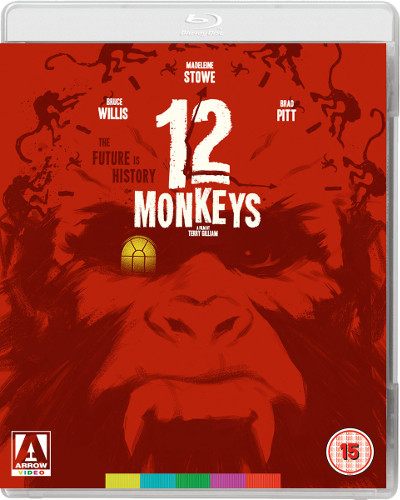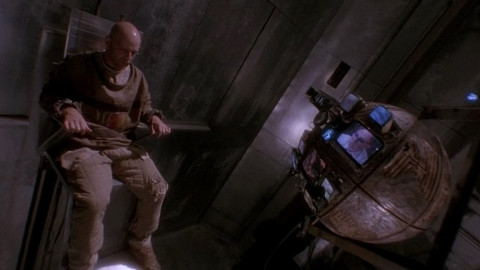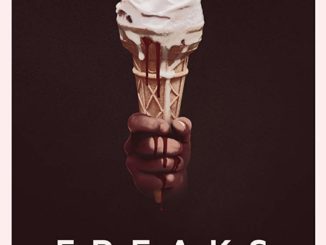12 Monkeys (1995)
Directed by: Terry Gilliam
Written by: David Peoples, Janet Peoples
Starring: Brad Pitt, Bruce Willis, Christopher Plummer, Madeleine Stowe
USA
AVAILABLE ON BLU-RAY: NOW, from ARROW VIDEO
RUNNING TIME: 129 mins
REVIEWED BY: Dr Lenera, Official HCF Critic
A deadly virus released in 1996 by a group known as the Army of the Twelve Monkeys wipes out almost all of humanity, forcing survivors to live underground. In 2035, James Cole is a prisoner living in a subterranean compound beneath the ruins of Philadelphia. Troubled by recurring dreams involving a foot chase and shooting at an airport, Cole is nonetheless selected to be trained and sent back in time to find the original virus in order to help scientists develop a cure. But he arrives in Baltimore in 1990, not 1996 as planned, and is arrested then hospitalised in a mental hospital on the diagnosis of Dr. Kathryn Railly. There he encounters Jeffrey Goines, a mental patient with fanatical views.…
With favourite directors, I think one tends to have an ultimate favourite that never changes, but after that the films are interchangeable. Quite often my second best loved film from a filmmaker is the one I’ve just watched. For me, Brazil will always be Terry Gilliam’s best work, but 12 Monkeys really is an astonishing work that reveals ever more depths whenever you see it. It’s hard to believe that Gilliam was a director for hire for this film, and that he suffered no studio interference despite it bearing many similarities with his 1985 masterpiece which he had to fight to get released, and in a version similar to his cut. But then again it was made during a brief time in which Gilliam was quite hot in Hollywood, making two major studio films in which he behaved – and both films turned out to be as Gilliam-esque as you can imagine yet were popular with both critics and audiences. Somehow I can’t really see The Fisher King being and released made the way it was now, and 12 Monkeys may even have trouble getting made – well, that’s if a big Hollywood studio would even want to take on such an offbeat, ambitious project nowadays. Gilliam and writers David and Janet Peoples’s unique take on the time travel movie is a complex web of ingredients coiling round each other, symbolised by the mandala of monkeys in the opening titles with its endless circles and no clear beginning or end – but it also manages to be one of Gilliam’s saddest, touching, even dare I say most human movies.
It was actually based on Chris Marker’s 1962 short film La Jetee. Comprising entirely of still photographs, it tells of an experiment in time travel in post-apocalyptic Paris done on a prisoner of war who keeps remembering a woman on a jetty. It was executive producer Robert Kosberg who got Marker to pitch the project to Universal Pictures, who reluctantly purchased the remake rights and hired David and Janet Peoples to write the screenplay which Gilliam was captivated by. He wanted Nick Nolte and Jeff Bridges to star and then had to persuade Bruce Willis to lower his fee to get the $29.5 million film, quite low budgeted for its type, approved for production. The other lead cast members then did the same. Not allowed the luxury of sound stages, the filmmakers had to find abandoned buildings or landmarks to use. The 2035 sets were filled with old technology found at flea markets and salvage warehouses. Shooting on location in Philadelphia and Baltimore in winter was fraught with weather problems and technical glitches, while some scenes had to be reshot due to continuity errors. Gilliam was afraid that Brad Pitt wouldn’t be able to pull off the nervous, rapid speech and sent him to a speech coach, but in the end he just took away his cigarettes, causing Pitt to get agitated and play the part exactly as Gilliam wanted. Gilliam also injured himself when he went horseback riding and – well – Gilliam took a whole day to do one shot [that he could have faked] in which the shadow of a hamster moves, so for the rest of the production, his perfectionism was nicknamed The Hamster Factor. Despite all this, he managed to stay within the budget and finished only a week behind his shooting schedule. The final cut did badly in test screenings and Universal initially only gave it a limited release, but it did so well it was expanded to a full one.
Opening text informs us of the catastrophe that will occur in 1996. It’s supposedly taken from the ramblings of a paranoid schizophrenic, but it soon becomes apparent that in this movie you can’t change what’s already happened. While the basic premise of the film is based on one of the oddest time paradoxes you’ll ever encounter in a film [which I’m going to try not to reveal just in case you haven’t seen it yet], it’s rather refreshing that it tells us that you can’t alter the past – which may be just as well considering there’s so much else to try to focus on. Initially James Cole is sent on a mission from the subterranean world to the surface, whereupon he wanders through a snowy, deserted Phildelphia inhabited only by the odd wild animal. We’re not told what crimes Cole has committed, but I wouldn’t be surprised if he hadn’t killed anybody. Willis, who is phenomenal in this film [Gilliam told him not to do any of his usual mannerisms], plays him partly as a seething mess of confusion and rage which is always in danger of boiling over, and partly as a lost child. Cole’s success in this mission leads him to be sent on a much more complex one – to find out who released the virus in 1996, not so that he can prevent the terrible event, but so that somebody else can get a sample and take it back to the future so that work can begin on a cure. But he’s sent to 1990 instead and is put in a mental institution, which is where both director and writers cleverly begin to suggest that Cole could actually be living in 1990 and that all the future stuff, not to mention the eradication of humanity, could be all in his head. There are many parallels between the future world and the asylum, like the five scientists behind a table trying to decide if Cole is the proper man for the mission in one world and the five scientists behind a table whether he’s sane or not in the other.
It’s the darkest of ironies that, when Cole first meets Goines, he’s the one to bring up the idea of wiping out humanity. Cole escapes from the asylum in an admittedly daft sequence, then is spirited back to 2035 – though he’s not there for long. Even though he has these odd dreams, shot in slow motion and bleached colours in contrast with the browny palette used elsewhere, it’s still decided that he should continue in his mission, though the incompetent scientists accidentally send him to World War 1 first before he decides to find his psychiatrist Kathryn from 1990 and get her to help him. Of course she doesn’t believe what he has to say, though she does seem to recognise him somehow. In a way Madeline Stowe has the hardest role out of the three leads. Willis has to be bewildered and disturbed while continually bleeding, sweating and drooling, while Brad Pitt decided to go all showy in a barrage of ticks and strange line deliveries which perhaps gets a little wearing. But Stowe has to play the most ‘normal’, ‘grounded’ character, the one with whom most viewers would probably most identify with, who has to eventually believe in some pretty crazy shit – and she does it very well indeed. The actors make the odd relationship between time traveler and psychiatrist almost believable and, while I could have done without the replaying of a moment from Vertigo replete with the same soundtrack soon after the pair have gone to see it in a cinema, it does in a way strengthen an idea of certain things being replayed. Yet the clock is still clearly ticking and Gilliam eventually gives us a finale at an airport which is the tensest sequence he’s ever directed – though it may be partly because I think the idea of a virus being carried by a passenger on a plane is so terrifying and plausible because it could be impossible to detect.
Cole does manage to get into a few fights, but the emphasis is less on external thrills than interior confusion, the major dilemma for Cole not being to save the world but to discover and survive himself. For once in a time travel film we have a real attempt to examine the psychological results that would probably occur from going from one year to another. Of course grungy depictions of the future are now common place, and here certain things from Brazil even turn up like those plastic see-through jackets. The art department made sure that the 2035 underground world would only use pre-1996 technology as a means to depict its bleakness. There’s a real nightmarish and paranoid feel to these scenes, especially when the scientists give Cole his instructions at a distance while a huge globe also hovers over him showing the faces of the same scientists on lots of little scenes. The creepy voice [in his head?] that often talks to Cole is also unsettling, as is the one time we see the mechanics of the time travelling, Cole being put into a blue see-through tank before being given various injections, then being shot on wires into a blackened chute in the wall. Of course the present is also looked at with that unique Gilliam eye with lots of wide shots, fish-eye lens shots, Dutch angles [which he maybe goes overboard on in the asylum scenes] and the like, and unsettling details like another time traveler who’s now homeless [see what I mean, time travel just isn’t good for you] every now and again popping up. Supporting characters tend to look creepy or seedy, like the fellow man on a mission sent to ‘help’ Cole’s, or the real villain of the piece which is a big surprise the first time you see the film.
12 Monkeys fits well in with Gilliam’s favourite theme of the real world vs a fantasy one, and it has a rather progressive, compassionate and uncritical look at what most of us would call madness to boot. Gilliam and the writers also clearly have some aspects about modern society they don’t like, but when they have Pitt deliver some of these at top speed it doesn’t feel like they’re preaching to us. A word to modern filmmakers: this is how you do it folks, make the viewer aware of the issues you want to talk about but try to refrain from lecturing him or her or do it in a way where it doesn’t seem like lecturing. We don’t want to feel like we’re at school when watching a film. Notable is the idea of technology changing the ways in which we communicate and in some cases not being as good [this is only one reason why 12 Monkeys doesn’t seem to have dated much], such as the constant cock ups with the phone line in the film. These and certain moments do provide some slight levity, while the main musical theme, a tango-like piece actually by Astor Piazzolla which seems out of place amidst the moody seriousness and weepy lamenting of Paul Buckmaster’s score, is decidedly humorous. Overall though 12 Monkeys is really quite a bleak exercise, though its mysteries, conundrums and weird existentialism are such fun to delve into it that one doesn’t leave it feeling too depressed despite the fact that its opening and closing shots are almost indescribably sad if you really think about them. They’re of the eyes of a small boy, and, however you interpret the film, are the eyes of somebody who’s seeing something highly traumatic which will haunt him for the rest of his life.
Rating: 









I own the previous Blu-ray from Universal, and despite using the same master as the DVD I always thought it looked good as well as retaining all the special features from the DVD release. Arrow’s Blu-ray presents a new 4K transfer and some comparing of the two discs reveals how much of an improvement it is and how flawed the older disc is. There’s so much more detail, all the blacks are now black, and skin tones are no longer erratic. The level of grain is just right too. Both audio tracks seemed almost the same on my simple setup, they sound quite modern and have quite a wide dynamic range without requiring you to alter the volume every now and agin
Arrow have added two special features of their own, but let’s quickly go through the old ones. The Audio commentary by Terry Gilliam and producer Charles Roven is a typically fine Gilliam track – in fact the two never stop talking, even going on till after the end credits have gone. The two throw as much production information, scene observations and stories at you as they can cram in, and you even get a sense of some of the mechanics of filmmaking, plus interesting observations such as first takes, even if imperfect, often being better because of their freshness. Favourite tales of mine include Pitt being so convincing when he was in an asylum for research that they didn’t want to let him leave, the mistaken use of a child actor whom the camera loved rather than the use of one who was better for the part, Gilliam having to fight for a smaller sized credit. Gilliam only occasionally goes into ‘attack’ more and generally seems very happy. Just as good as the commentary is The Hamster Factor and Other Tales of Twelve Monkeys, an excellent ‘making of’ documentary that only sometimes repeats material from the commentary. Gilliam and Roven continually speak as we are taken through the stages of making and releasing the film with lots of ‘fly on the wall’ footage. Even things like music and publicity [check out some of the early poster designs] are covered. We see the building of that amazing future set, Willis wondering to Gilliam and Stowe if the audience will work out the ending or not, and how going into one of the locations led to the time machine, which hadn’t previously been thought of, being thought up and created. I could personally have done with less of the quick montages, but even if you don’t like the film, anyone interested in filmmaking should watch this.
The new special features begin with The Film Exchange with Terry Gilliam where he’s interviewed at the London Film Festival in 1996. In a good mood, he answers typical questions and provides some interesting facts, like how Willis agreed not to have his entourage on set but insisted that his gym followed him everywhere even though he never used it, and how the similarities to Brazil in the future scenes were in the Peoples’s script. And then we have the Appreciation by Ian Christie which basically just sums everything up but is nice to have anyway.
In my opinion, if you’re a fan of the film then Arrow’s release is worth the upgrade even if you have the previous Blu-ray – the difference really is striking and at least one of the special features is very much worth having. If you haven’t seen it, then as long as you’re prepared to do some serious thinking, then jump straight in – for a start it proves that a very unique talent can successfully work within the studio system and still deliver something that doesn’t compromise at all. Thoroughly Recommended!
SPECIAL EDITION CONTENTS
*Brand new restoration from a 4K scan of the original negative by Arrow Films, approved by director Terry Gilliam
*Optional DTS 5.1 Master Audio and 2.0 stereo soundtracks
*Optional English subtitles for the deaf and hard-of-hearing
*Audio commentary by Terry Gilliam and producer Charles Roven
*The Hamster Factor and Other Tales of Twelve Monkeys, feature-length making-of documentary by Keith Fulton and Louis Pepe [Lost in La Mancha] [87 mins]
*The Film Exchange with Terry Gilliam, a 1996 interview with Gilliam and critic Jonathan Romney, recorded at the London Film Festival [21 mins]
*Brand-new appreciation by Ian Christie, author of Gilliam on Gilliam [16 mins]
*The Twelve Monkeys Archives
*Theatrical trailer
*Reversible sleeve featuring original and newly commissioned artwork by Gary Pullin
*FIRST PRESSING ONLY: Illustrated collector’s booklet featuring new writing on the film by Nathan Rabin and archive materials








Be the first to comment